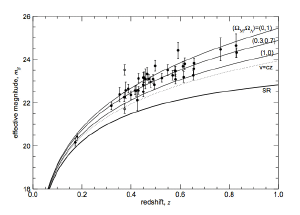Blog
Traveling Without Moving
21 March 2014
 ShortGreenPigg via DeviantArt
ShortGreenPigg via DeviantArtWith all the news about BICEP2 and the possible detection of early inflation, there have been a lot of misconceptions about what inflation actually is. One of the biggest is the idea that during inflation the universe expanded faster than light. It’s a misconception that even many experts get wrong, and is so common that there’s a technical arxiv paper addressing these misconceptions.1 It’s easy to see how this misconception arises. After all, during inflation, two atoms a meter apart just before would find themselves about a light year apart within a fraction of a second. How is that not moving faster than light? It all has to do with the subtlety of general relativity.
Before we talk about inflation, let’s talk about a similar effect we see in the universe today, known as cosmic expansion. When we look at distant galaxies, we see that the light of more distant galaxies is redshifted more than closer galaxies. Now we know that light can be redshifted when objects move away from us, known as the Doppler effect. For this reason, this effect is often described as galaxies moving away from us. But redshift can also occur due to the expansion of space itself. That is, space expands, but the galaxies aren’t moving through space. The first is a property of special relativity, and is due to the motion of objects through space. The second is a property of general relativity, and is due to an expansion of space.
 Davis and Lineweaver
Davis and LineweaverSince both effects give a redshift to distant galaxies, how do we know that cosmic expansion is due to an expansion of space and not relative motion? If the redshift were due to relative motion, then the light of distant galaxies would be redshifted when leaving the galaxy, and that means the light would also appear dimmer. If the redshift is due to cosmic expansion, then light leaves a distant galaxy without being redshifted, and therefore also not dimmed. Only later is the light redshifted due to expansion. This means you can compare the brightness of distant supernovae with their redshift, known as the magnitude-redshift relation. What we find is that the magnitude-redshift relation matches expansion extraordinarily well. It doesn’t match the relative motion model at all.
So we know that space is actually expanding, but what does that actually mean?
Cosmic expansion is determined by what is known as the Hubble constant. Currently our best measurement of the Hubble constant is about 20 km/s per million light years. This means that two points in space a million light years apart are moving away from each other at 20 kilometers each second. Since all of space is expanding, the greater the distance between two points in space, the faster they move apart. So two points 10 million light years apart are moving away at 200 km/s, and so on. Because of this, if you consider two points far enough apart, they will be moving away from each other faster than the speed of light. The speed of light is about 300,000 km/s, which, given our current Hubble constant is the separation speed for two points 15 billion light years apart.
Now you might think then that a galaxy 16 billion light years away from us must be moving away from from us faster than light. You could say that the the galaxy appears to be moving faster than light, but in actuality it is space that is expanding between us. The galaxy itself isn’t moving much at all. It’s not as if that distant galaxy is defying relativity. After all, from that distant galaxy’s perspective we are moving away from it faster than the speed of light. The key point to remember is that this is due to cosmic expansion, not galactic motion. And cosmic expansion is not faster than light, even though very distant objects can appear to be moving faster than light.
Which brings us to inflation. Many of the popular articles unfortunately state that during inflation the Universe was expanding faster than light, which isn’t true. What is true is that during inflation the rate of spatial expansion was much larger. This means that the distance at which objects appear to move apart faster than light is much smaller, but it does not mean that the Universe expanded faster than light.
We still don’t understand the mechanism that triggered inflation, but we do know that inflation doesn’t violate the speed of light. During inflation the rate of expansion was tremendous, but even today space continues to expand, just at a much smaller rate.
Davis, Tamara M., and Charles H. Lineweaver. “Expanding Confusion: common misconceptions of cosmological horizons and the superluminal expansion of the Universe.” Publications of the Astronomical Society of Australia 21.1 (2004): 97-109. ↩︎